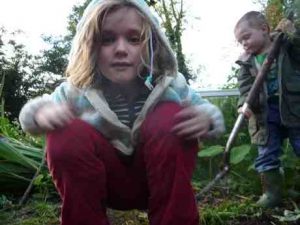
We think that a good way to maintain the dignity of people confined to hospitals for a long time could be to make them experiment a piece of the real world. The idea to take care of a real garden thanks to the technology (sensors, processors and actuators and video-cameras that broadcast in real time what is happening in the garden) could be inspiring to them. It’s important to point out that the project is not based on the simulation but in the real process of making vegetables and plants to grow.
Moreover, if at the same time, we allow patients to smell, touch and have a direct control on the flowers and plants sited on the hospital, patients would obtain an embodied experience reach in stimulus.
All the ideas related to recovering the body are very important in the project. I have the idea that the inspiring bodily experiences are able to strengthen the soul of people and therefore, get them well and recover healthy. I would like this project could be implemented and motivates children to get better.
SOME IDEAS TO IMPROVE THE PROJECT
Penny, Simon: (talking about Hutchins) “He analyzed the group activity of navigation on a ships bridge as a case of distributed cognition, in which a group of people performing specific roles and communicating to each other in specific ways, using a highly developed set of tools perform computational tasks.” [1]
The concept of «distributed cognition» is a important concept in the Parsley Project. This distributed cognition is going to put in contact all the members of the community: gardeners, volunteers, children and all the people invited by them to collaborate to look after their plants. Children are going to control this group, having the total freedom and deciding who can take part. At the first time, we are going to give them the tools to communicate all the member of the community. From the moment we set up the experience on children would take the control and decide how they want to use the communication tools.
Maybe, children decide to talk about soccer with their friends from the school and forget to water the plants. I assume that children are going to adapt the technology in ways we couldn’t imagined before but I think that the process to understand them is going to be really exciting.
On the other hand, if illness has dramatically changed the child’s social life, we have to take care about his new socialization inside the hospital. One of the motivations that could make a patient to be interested in the Parsley Project is the possibility to interact with other children. Should be these children living also inside the hospital or could be better to interact with external and healthy children? I’m not sure but I like the idea of sharing an area of the garden with other people, and take important decisions in groups.
2. Ubiquitous, Calm technologies and Equilibrium
Penny, Simon: “This new cognitive science is immediately relevant to the still-vexed “human factors” aspect of ubiquitous computing, precisely because it addresses aspects of human experience pertinent to the development of richer and more subtle, if no calmer technologies of interaction.”[2]
Dreyfus, Hubert L.: “According to Merleau-Ponty, in everyday, absorbed, skillful coping, acting is experienced as a steady flow of skillful activity in response to one’s sense of situation.”[3]
I would like to find the way to integrate all the interfaces of the project in the children’s rooms, but at the same time I would like to do it in a transparent way, avoiding the children and the doctors’ perception that the technology is invading the children’s place. About this idea, it’s important to know which are the hospital restrictions based on medical reasons about the use of Wi-fi or another data transfer systems.
I could imagine a big screen trying to simulate a window to the garden (to their own allotment in the public garden), switching on automatically in the morning, at the time to wake up. But isn’t this idea nothing more that the construction of a world that it’s inaccessible for ill children?
Also against the extended idea of the intrusion of computation everywhere, children should be able to communicate with the «Parsley community» with a portable and easy interface on his mobile phone, that he can switch on and off when he wants.
I think that the tangibility of this application will depend on, as Penny wrote, “the understanding of being-in-the-world, or, rather of a performative doing-in-the-world”. Interface has to be like one candy that children want to eat, without questions about the quantity of sweets they eat during the day or its quality. We are going to get tangibility if we understand children genuine interest and we manage to give suitable answers to their needs.
This last concept is deeply related with the Dreyfus idea of equilibrium, as far as all the experience and the system has to be able to evolve in a continuum, always changing according to the children expectations and needs.
3. Sense experience as a vehicle of knowledge, beauty and even ethics
Marks, Laura U.: “Across the membrane between communicability and incommunicability, the proximal senses build an intensity that is not social but is the meaningful lining of experience.”[4]
It’s also essential to give to the experience design a unique aesthetic connotation. Technology has to be ubiquitous but also delightfully beautiful.
If vision and hearing “are strongly associated with abstraction and transcendence because of their ability to seem independent of the body” [4] the embodied nature of the close senses of touch, taste, and smell is more evident, and thus they ability to link us to the material world. While vision and hearing senses are a constant features in the project (they can always see and hear what is happening in the garden), another senses like touch, taste, and smell are not so obviously included. After the classes I’m going to reinforce their presence at the project.
On the one hand, since the first days of this project I’ve attached importance to the use of touching interfaces on it. Also, children have a direct and tactile experience with the plant of the hospital, that can touch and water.
On the other hand, the sense of taste also comes in when harvested products return to the hospital and children can eat them (of course, we are going to use a biological standards in the process to make them grow).
Lastly, the mot inspiring and emotional sense is preset at the flowers of the hospital garden that should counteract the typical smelt that hospital have.
Niedderer, Kristina: “Mindfulness as a state of awareness or consciousness implies my presence to the moment, where I look at my experience, rather than though it (…) Another consideration is the awareness or attentiveness of something”.[5]
At this point of the process of re-thinking my project, promoting mindfulness among children arises as the most important challenge. How can I create mindful interaction in a virtual context? And how can I guarantee enduring mindfulness when the life of some of the participants could hang by a thread?
On the other hand, how can I get them be aware of the importance of the constant cares that plants need? And how to reach their attentiveness to all the plants growth process?
I think that approaching the consequences of their actions to them by the visualization in real time by videocameras could play an important role. I also think that the child has to be able to interact directly with the garden, ordering some actions as watering. In this way, he could be able to see how the watering system has been triggered. But, does is it possible to extend the range of action than could be triggered from the hospital? Or, in another words, could be possible to mechanize another functions? I don’t think so if we cannot make the experience much more expensive. Mindfulness but also economically approachable. After all, we are in Spain and the present situation is not buoyant!
[1] [2] Penny, Simon. Trying to be calm: Ubiquity, Cognitivism and Embodiment
[3] Dreyfus, Hubert L. The Current Relevance of Merleau-Ponty’s Phenomenology of Embodiment
[4] Marks, Laura U. Thinking Multisensory Culture
[5] Niedderer, Kristina Designing Mindful Interaction: The Category of Performative Object





